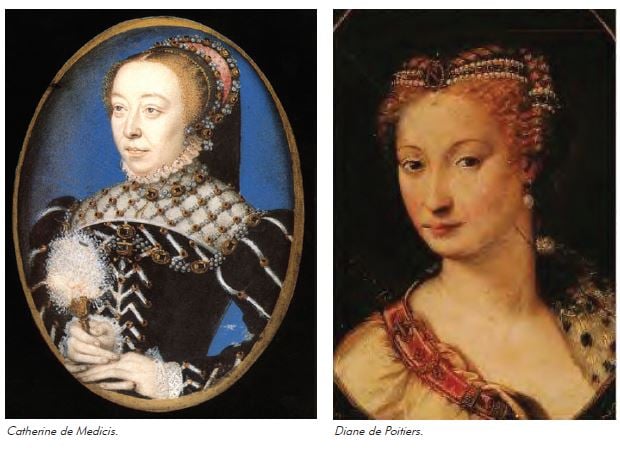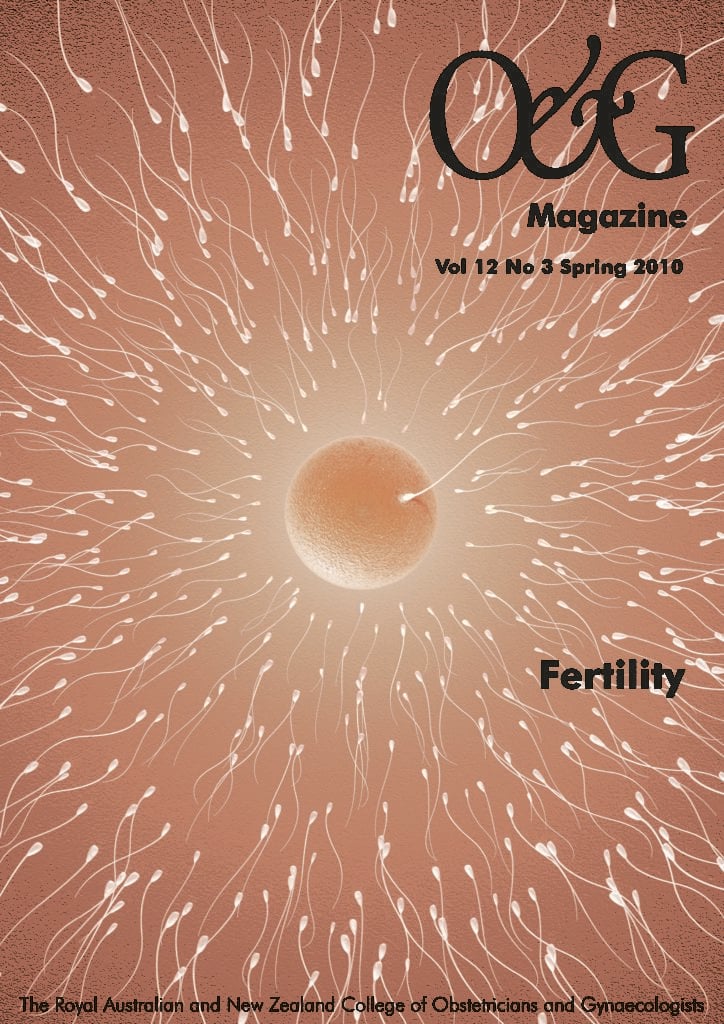That vouchsafes them the fruit for which they pray.’
– Margaret of Navarre, writing to her sister-in-law, Catherine de Medicis, on the birth of Catherine’s first child.
On June 30 1559, the French Court was at Paris for the marriage celebrations of Philip II of Spain to Elizabeth, daughter of Henry II of France and his Queen, Catherine de Medicis. The marriage had been arranged to cement the recent peace treaty of Cateau-Cambrésis that ended a series of wars with the Spanish for the control of Italy. Following the wedding, a tournament was arranged for the entertainment of the guests; the participants included Henry himself, who was struck in the eye, inadvertently, by the lance of Captain Montgomery of the Scottish Guard. Henry died ten days later, leaving the throne to his 15 year-old son, Francis II. Francis lacked both maturity and experience so real power passed into the hands of his mother, Catherine, who was to reign, sometimes unofficially and sometimes as Regent, for the next thirty years.
History has not dealt kindly with Catherine, who is popularly considered both wicked and scheming. To determine her true character has become very difficult, novelists and film-makers having portrayed her as frequently as historians. Alexander Dumas for one shows her as inherently evil, plotting with her Florentine perfumer and poison maker, Réné, to murder her own son-in-law, the future Henry IV. Balzac on the other hand described her as ‘a great king’. Most serious historians of the period see her as moderate, concerned and rational, doing a difficult job at a difficult time, steering a path between Catholic and Protestant forces equally passionately involved in the Wars of Religion that engulfed France between 1560 and 1590.
Three of Catherine’s sons were kings of France. The first was the inadequate Francis, who suffered chronic otitis media that progressed to a fatal cerebral abscess in 1560. The renowned French surgeon Ambroise Paré was called in and wanted to try burr holes to let out the pus. This was a new procedure – Paré had performed it only three times previously. Catherine hesitated and Francis died. Charles IX succeeded him, Catherine acting as Regent for the first three years of the reign. Charles was in poor physical health, mentally unstable, cruel and vain. It was he who took the decision to assassinate the Protestant leader Coligny, a botched attempt which led to the St Bartholomew’s Day Massacre for which Catherine has traditionally been blamed. Charles died in 1574 and Catherine was again Regent while her third son Henry III returned from his previous post as King of Poland to take up the crown of France. Henry was weak and easily influenced by the Catholic party. He seemed more attentive to the trappings of power than to its substance and failed to end the religious wars despite Catherine’s ongoing efforts in this direction. Stabbed by a fanatical Jacobin friar in 1589, on his deathbed he acknowledged as his heir the Protestant Henry of Navarre, who converted to Catholicism to become Henry IV, remarking, it is said, that ‘Paris is worth a Mass’. Henry IV’s tolerance of the Protestant Huguenots finally brought the wars to an end.
Catherine’s marriage to Henry II was first suggested when she was only six years old and formally arranged when she was eleven. Catherine herself was never consulted – the marriage was political, made so that France could keep a foot in Italy. At the time, Henry was only the Second Son of France, so the alliance was not seen as particularly important until some years later when his brother died. Catherine’s mother, who came from the French nobility, had died of puerperal sepsis within days of her birth, and soon afterwards her father, Lorenzo de Medicis, perished from a fever. The orphaned Catherine was brought up, in a Florence frequently subject to war, under the guidance of her uncle, who happened to be the Pope, Clement VII.
It was Francis I, father of Henry II and lover of all things Italian, who organised the match. The marriage was not popular in France. Catherine’s dowry was considered too small and alliances between royalty and merchant families like the Medicis, however rich, were still unusual. Catherine would later be referred to contemptuously in France as ‘the shopkeeper’s daughter’.
Nevertheless, the wedding did take place, at Nice in 1533. So richly bejewelled was Catherine’s wedding gown that it was impossible to tell its colour. It was considered that the couple were old enough (they were both 14) to consummate the marriage; presumably Catherine had already reached her menarche. Francis I ‘put them to bed to watch them jousting and they jousted valiantly’ and the Pope waited 34 days to see if his niece had conceived, but in vain. ‘Never mind,’ he consoled her, as he prepared to leave for Rome, ‘a clever woman can always have children.’ However, Catherine had none for ten years.
As a gynaecologist I find this intriguing, especially as the birth of Francis II, Catherine’s first child, in 1544, was followed by the arrival of nine siblings. One son died in infancy and Catherine’s final delivery, in 1556, was of twins (one a neonatal death, the other a stillborn breech extraction). Nearly five centuries later, knowing something of the personalities involved, I venture to suggest a possible cause for Catherine’s initial infertility, and the likely means of its resolution.
Henry II, as a child, was sent as a hostage to the Spanish court, as part of the ransom paid for his father, Francis I, taken prisoner in Italy. Henry did not return to France until he was eleven. On his return, his father found him a morose child and entrusted him to the care of a woman then at Court, Diane de Poitiers. Diane had been married very young to an aging aristocrat, who conveniently soon died.
Much has been written about the beauty of Diane and the few authentic portraits available do show her to have been very lovely. Already in her thirties by the time she took over Henry’s care, Diane is said to have preserved her beauty with cold water, eschewed cosmetics and refused to dye her hair. Whilst initially her role was a maternal one, when Henry was 17 years old (and three years married to Catherine) they became lovers. Their relationship continued up until his death, when Diane was 60 and Henry 41. Diane exercised enormous influence over Henry’s life, decisions and appointments. As Royal mistress, she was always placed near Henry at official engagements; he gave her land, castles and most of the crown jewels.

Henry, Catherine and Diane thus formed a ménage à trois throughout Henry’s adult lifetime. Though cordial to Diane while Henry was alive, Catherine was very jealous. ‘Never has a woman who loved her husband liked his whore,’ she observed in a letter to one of her children many years after Henry’s death. It appears that she loved him deeply, while he cared little for her, although he was devoted to their children when they finally made their appearance.
It has been well-documented that Catherine shared Henry’s bed frequently, at Diane’s bidding: ‘Diane obliged Henry to sleep assiduously with his wife,’ wrote one contemporary. So lack of opportunity was not the reason Catherine was failing to conceive. A more relevant detail perhaps is the fact that Henry had hypospadias. There are several reports of this including that of a 16th century physician, Nicolas Venette. As Henry eventually had at least 13 children, it is likely that the hypospadias was glanular or anterior penile, although history has not recorded this detail. In 1538, he supposedly proved his fertility by fathering a daughter with an Italian woman, Filippa Duci. The girl, named Diane de France, was brought up by Diane de Poitiers, who was rumoured to be her real mother.
As pregnancy eluded Catherine, she became increasingly desperate in her search for a solution. She surrounded herself with doctors, diviners and magicians. Given how little was known of female physiology, it is unlikely that any of their philtres and potions had much effect. As well as being a devout Catholic, Catherine was a firm believer in astrology and consulted the leading astrologists and fortune tellers of the day, including Nostradamus, who is said to have told her she would be the mother of three kings of France. She hung herself with medals and charms and would not ride on the back of a mule, since that animal is infertile.
One of the doctors she consulted was the prominent French physician Jean Fernel and some historians have attributed the cure of her infertility to him. Fernel translated works of the Roman physician Galen, believing that medical progress lay in resurrecting classical learning. He had, however, little knowledge even of such gynaecology as there was in the 16th century. He himself always denied having prescribed any treatment that might have brought about a solution, although he had no objection to people thinking so at the time – his reputation was greatly enhanced.
Other historians have speculated that Henry had an operation to correct the hypospadias. Surgery of all kinds was, however, in its infancy, anaesthesia and antisepsis unknown. Ambroise was at the stage of ligating bleeding vessels from war injuries, rather than pouring boiling oil over them. Summoned to the dying Henry II, he could do nothing to save him. It is inconceivable that any surgeon would have operated upon the Royal member to correct a congenital anomaly, or even imagined that by doing so he might solve what would have been thought of as Catherine’s problem. Surgery for the correction of hypospadias was not developed until the late 19th century.
Undoubtedly, Catherine’s failure to conceive was of concern to Diane. Her power at Court was enormous and she wanted to keep that power. If Henry’s marriage remained childless, if there were no male heir to the throne, divorce was inevitable. Indeed divorce was being encouraged by the powerful Guise family, who were close to the Court and who had a suitable bride ready. Catherine was docile and the arrangement suited Diane, but another wife might not be so amenable. Once Catherine achieved pregnancy, it must have suited Diane for her to be occupied with a confinement every year, leaving Henry free to devote more time to his mistress.
Diane would have known better than anyone the intricacies of the king’s anatomy and function, and she probably had a good idea of Catherine’s. Catherine is on the historical record as having holes bored in the roof of Diane’s bedchamber, so that she could watch her husband and his mistress disport themselves; she is said to have found the spectacle very different from the disinterested performance she experienced in the marital bed. It is very possible that Catherine had a retroverted uterus. If this was the case, intercourse always in the missionary position with a perfunctory husband, and hypospadias present, then the problem may have been purely mechanical. Diane, a clever woman, may have given some advice to Catherine: turn on your stomach for ten minutes after lying with the king, ma chérie, or try different positions. Catherine, obeying such instructions and finding the counsel successful, would certainly have done the same thing again, achieving nine full-term pregnancies in 12 years.
Unfortunately, if such wisdom was offered, this was not recorded for posterity. We shall never really know the reasons for Catherine’s interesting obstetric history. After Henry’s death, Catherine, now virtual ruler of France, turned against Diane. She and her friends were banished from Court, she was made to give up her beautiful château on the Loire and to return the crown jewels. Historians continue to debate Catherine’s character and her role in the wars and politics of France, but there is no doubt she wielded enormous power in the last 30 years of her life. This power was entirely due to her role as the mother of sons who were kings of France; as a woman she could not have ruled in her own right. Had she never conceived, she would have been divorced and a non-entity. Catherine may well have owed her influence and her fame, which continues to this day, to Diane’s prudent efforts to overcome her long years of barrenness.
References
- Héritier J. Cathérine de Medicis. Trans. C. Haldane. London: Allen and unwin, 1963.
- Van Dyke P. Catherine de Medici. New York: Scribner, 1922.
- Lavisse E. Histoire de France. Paris: Hachette, 1911.
- Dumas A. La reine Margot. Paris: Boutan-Marguin, 1968.
- Balzaz H. Sur Cathérine de Medicis, in La Comédie Humaine. Paris: Editions de Seuil, 1981.
- Herpin J. Jean Fernel, Médecin et Philosophe. Paris: Baillière, 1949.
- Mondor H. Ambroise Paré. In Dumesnil R, Bonnet-Roy F eds. Les médecins célèbres. Paris: Mazenrod, 1947.






Leave a Reply